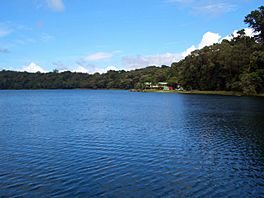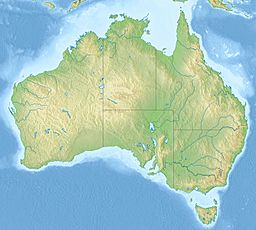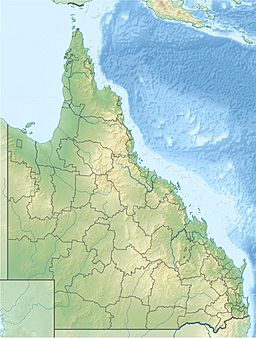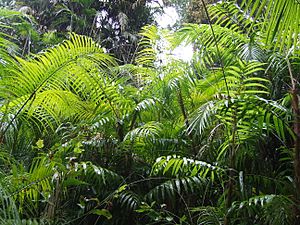Lake Barrine facts for kids
Quick facts for kids Lake Barrine |
|
|---|---|

View from a cruise
|
|
| Location | Lake Barrine, Queensland |
| Coordinates | 17°15′01″S 145°38′07″E / 17.25028°S 145.63528°E |
| Type | Crater lake |
| Primary inflows | precipitation |
| Basin countries | Australia |
| Max. width | 1,230 m (4,040 ft) |
| Average depth | 35 m (115 ft) |
| Max. depth | 65 m (213 ft) |
| Shore length1 | 4.5 km (2.8 mi) |
| Surface elevation | 730 m (2,400 ft) |
| 1 Shore length is not a well-defined measure. | |
Lake Barrine is a beautiful freshwater lake in Far North Queensland, Australia. It's located on the Atherton Tableland, near another lake called Lake Eacham. This special lake and the area around it are part of the Crater Lakes National Park. You can easily get there by driving on the Gillies Highway.
Contents
How Lake Barrine Was Formed
Lake Barrine was created more than 17,000 years ago. It started when a huge volcano exploded. This explosion happened because hot melted rock, called magma, mixed with water underground. This created a lot of steam and pressure.
The pressure built up so much that it blasted out the center of the volcano. This left a giant hole in the ground, called a maar or crater. Over time, rainwater filled this crater, forming the clear lake we see today. Local Aboriginal people called the lake Barany.
What Lake Barrine Looks Like
Lake Barrine is the biggest natural volcanic lake in its area. It sits about 730 meters (2,395 feet) above sea level. The lake is about 1 kilometer (0.6 miles) wide. Its shoreline stretches for almost 4.5 kilometers (2.8 miles).
The lake is quite deep. Its average depth is 35 meters (115 feet), and it can be as deep as 65 meters (213 feet). No rivers or springs flow into Lake Barrine. It is filled only by rainwater, which makes its water very clear. During the wet season, a small creek flows out of the lake. This creek eventually joins the Mulgrave River.
Things to Do at Lake Barrine
Lake Barrine is a great place to visit. There are walking tracks all around the lake. You can take a relaxing cruise on the lake with tour operators.
The area has picnic grounds where you can enjoy a meal outdoors. There's also a kiosk and a historic tea house. This tea house was built way back in 1926. Visitors can also swim in the lake. It's also a good spot for birdwatching. Please remember that camping and pets are not allowed near the lake.
Animals and Plants of Lake Barrine
The rainforest around Lake Barrine is full of amazing plants. You can find giant kauri trees (Agathis microstachya). There are also red cedar trees (Toona ciliata) and flowering umbrella trees (Schefflera actinophylla).
Many animals live in this area. You might see eastern Australian water dragons. Giant eels and saw-shelled turtles live in the water. On land, you could spot scrub pythons (Morelia kinghorni).
Many different birds also call Lake Barrine home. These include pied cormorants, black ducks, and plumed whistling ducks. You might also see black coots, whistling kites, brahminy kites, and black kites. Look up for the majestic white-breasted sea eagles. Finally, dusky moorhens are also common here.
Lake Barrine During World War II
During World War II, the tea house at Lake Barrine was used for a special purpose. The Australian Army used it as a place for soldiers to rest and recover. It served as a convalescent home for them.





